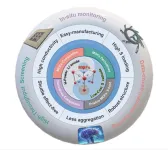Achieving the Healthy People 2030 youth sports participation goal could save the United States $80 billion in direct medical costs and productivity losses and deliver over 1.8 million more quality years of life to Americans, according to a study that will be published on Feb. 27 in the American Journal of Preventive Medicine.
Every decade since 1980, Healthy People has provided science-based, 10-year national objectives and targets aimed at improving the health and well-being of the nation. The findings from the study are based on results from a computer simulation model of all youth (ages 6-17 years old) in the U.S. developed by the PHICOR team at the CUNY Graduate School of Public Health & Health Policy (CUNY SPH) to show what could happen if our nation’s youth sports participation went from the current level of 50.7% to the Healthy People 2030’s goal of 63.3%.
“Our study shows how achieving this major public health goal outlined by Healthy People 2030 can not only help to prevent diseases and save lives, it can also save our economy billions of dollars,” says Bruce Y. Lee, MD, MBA, executive director of PHICOR, professor at CUNY SPH, and senior author of the study. “And those savings will keep recurring if the United States can maintain that level of youth sports participation.”
For this study, the PHICOR team worked with the Aspen Institute’s Project Play initiative and collaborators from the U.S. Department of Health and Human Services (HHS), Adelphi University, Stellenbosch University, University of Texas at Austin, Utah State University, and Michigan State University. The team developed a computational model to represent U.S. youth participation in sports and tracked their weight changes and mental health outcomes (e.g., anxiety, depression) up until they turned 18 years old. The model also simulated and tracked the associated weight-related health outcomes (e.g., diabetes, stroke, heart disease, cancer) that they could experience over their lifetimes. Results showed that achieving the Healthy People 2030 youth sport participation goal could decrease overweight and obesity prevalence by an absolute 3.37%, resulting in 1.71 million fewer cases of overweight/obesity among the youth cohort. Results showed reaching the Healthy People 2030 goal could gain over 1.8 million quality years of life.
“In general, people agree that there are many benefits to playing sports and being active, but our study is the first of its kind to quantify the impact of sports participation on kid's physical and mental health as they grow up, "says Marie Martinez, MPH, project director at PHICOR and first author of the study. "This is not only helpful for showing the current and future impact of increasing sport participation, but can also help decision makers determine how to invest and allocate resources to increase participation.”
A major contributor to the billions of dollars in cost savings was the extent to which increasing physical activity through sports participation helped prevent weight-related health outcomes. The resulting physical health improvements from increasing youth sports participation could avert 352,000 cases of weight-related diseases such as type 2 diabetes, coronary heart disease (CHD), stroke, and cancers across the 6- to 17-year old cohort’s lifetime. This saves over $22 billion in direct medical costs and over $25 billion in productivity losses due to improvements in physical health.
The associated cost savings of increased physical activity were not just due to physical health but mental health benefits. Previous studies have shown that playing sports can reduce anxiety and depression symptoms among adolescents in particular. The findings from the current study showed that the overall reduction in depression and anxiety symptoms from achieving the Healthy People 2030 sports participation target would save $3.61 billion in direct medical costs and $28.38 billion in productivity losses across the youth cohort.
The cost savings far exceed current investment into increasing youth sports participation. For context, before the pandemic, the Aspen Institute estimated that $30-$40 billion was spent by families on youth sports based on surveys and national sport participation data. This means that the investment in youth sports could double and still result in net cost savings across the youth cohort’s lifetime. Further, the overall findings may be on the conservative side as the model did not account for chronic health conditions outside of weight-related ones (e.g., osteoporosis), potential indirect effects of sports participation (e.g., improved diets/nutrition, decreased substance use), nor the impact of sports participation on academic performance, social skills, emotional regulation, or mood.
Even just moving the needle on participation by a relatively small amount can save billions of dollars. For example, just increasing youth sports participation back to pre-COVID levels, 58.4%, could save a total of $29.17 billion. Youth sports participation levels took a hit in 2020-21 in part due to the effects of the COVID-19 pandemic and the associated impact that social distancing requirements had on kids’ ability to to regularly play sports.
“We’re dangerously close to having a nation in which most children no longer play organized sports,” said Tom Farrey, executive director of the Aspen Institute’s Sports & Society Program, founder of Project Play, and co-author of the study. “We’ll rally the Project Play network of leaders to lift participation rates but sport organizations can’t do this alone. We need the help of public health, education, government, philanthropy and other sectors that touch the lives of kids – those that will derive many of the benefits and cost savings of getting and keeping more kids in the game.”
Several organizations have identified opportunities to increase participation that could guide these investments. For example, the Aspen Institute's Project Play initiative developed eight shared strategies to increase sports participation, including revitalizing in-town leagues, promoting sport sampling, and designing sports programs anchored in the principles of developmentally appropriate play for youth. Additionally, the National Youth Sports Strategy provided approaches like developing shared-use agreements to facilitate access to public or private play spaces outside their normal hours. Moreover, results from this study can set the stage for identifying interventions and policies designed to achieve the Healthy People’s youth sport participation goal and beyond.
About CUNY SPH
CUNY SPH is committed to teaching, research, and service that creates a healthier New York City and helps promote equitable, efficient, and evidence-based solutions to pressing health problems facing cities around the world.
About PHICOR
Since 2007, PHICOR, Public Health Informatics, Computational, and Operations Research (www.PHICOR.org) has been developing computational methods, models, and tools to help decision makers better understand and address complex systems in health and public health. Follow @PHICORTeam on Facebook, LinkedIn, YouTube, and Twitter for updates.
About the Aspen Institute’s Project Play
An initiative of the Aspen Institute Sports & Society Program, Project Play develops, applies and shares knowledge that helps stakeholders build healthy communities through sports. Visit www.ProjectPlay.org.
About Adelphi: A modern metropolitan university with a personalized approach to higher learning
Adelphi University is dedicated to transforming students’ lives through small classes with world-class faculty, hands-on learning and innovative programs supporting academic and career success. Long Island’s oldest private coeducational university, Adelphi is consistently ranked as a Best College by U.S. News & World Report. More than 7,400 students are enrolled at our main campus in Garden City, New York—just 23 miles from New York City’s cultural and internship opportunities—and at dynamic learning hubs in Brooklyn, the Hudson Valley and Suffolk County, as well as online.
About Centre for Sport Leadership, Stellenbosch University
The Centre for Sport Leadership (CSL) is a unit within Maties Sport (sports directorate) at Stellenbosch University (South Africa), that was created in 2019. Its objectives are to conduct leadership development within a sporting context for student-athletes, coaches and general sport practitioners and administrators. The Centre also provides thought leadership on key issues within South African, African and Global sport, through impactful partnerships and by conducting and facilitating interdisciplinary research for impact.
About Michigan State University
Michigan State University has been advancing the common good with uncommon will for more than 165 years. One of the world's leading public research universities, MSU pushes the boundaries of discovery to make a better, safer, healthier world for all while providing life-changing opportunities to a diverse and inclusive academic community through more than 400 programs of study in 17 degree-granting colleges.
About Utah State University
Utah State University is a premier land- and space-grant institution committed to excellence, access, and inclusion. Since its founding in 1888, USU has evolved from a small agricultural college tucked away in the Northern Utah mountains to a thriving, R1 research university with locations serving the entire state of Utah and known throughout the world for its intellectual and technological leadership.
###
END





